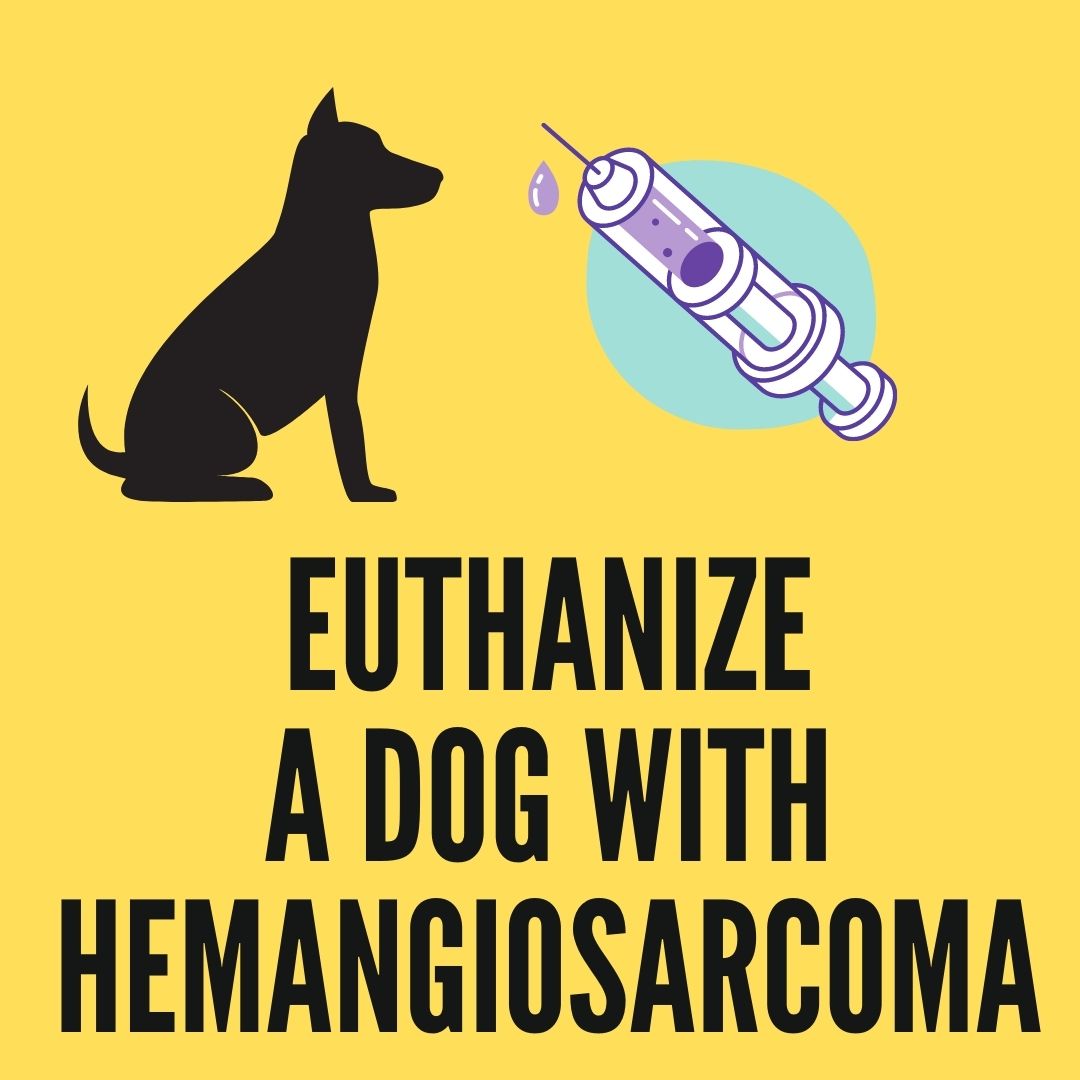“When to euthanize a dog with hemangiosarcoma?” is common question pet parents ask. Hemangiosarcoma is also known as HSA. It is a type of malignant cancer that affects endothelial cells. These cells are responsible for lining the blood vessels. Hemangiosarcoma does not show any early symptoms. Most of the symptoms are non-specific shown only after some major events like hemorrhage or ruptured tumor.
Hence it is difficult to identify cancer without a proper diagnosis. This also affects the time that they require to decide to euthanize the dog.
First, let us try to understand what is hemangiosarcoma and how deadly it is.
Contents
Is hemangiosarcoma a death sentence?
Hemangiosarcoma is the cancer of blood vessel walls. It is most commonly seen in golden retrievers, boxers, and german shepherds.
Hemangiosarcoma can occur on the surface of the skin or inside the body cavity. The one that affects the surface of the skin has fair chances of recovery. But, the one inside is mostly fatal.
Hemangiosarcoma inside the body affects the heart, liver, or spleen by developing some growth. These are difficult to detect until the dog starts showing symptoms. This cancer can easily spread throughout the body and develop blood-filled tumors anywhere. When one of the tumors bursts, it causes internal bleeding which makes the dog very weak.
Hemangiosarcoma is a very serious cancer that affects the blood vessels cells, regularly forming hundreds in the heart or spleen. The cancerous tissue forming those hundreds isn’t as robust as everyday tissue and might rupture when packed with blood, inflicting surprising internal bleeding and probable death.
Types of hemangiosarcome
- Dermal hemangiosarcoma
This hemangiosarcoma is visible. The growths can be seen on the skin. You can surgically remove them but there is always a chance of internal metastasizing.
- Subcutaneous hemangiosarcoma
Subcutaneous hemangiosarcoma develops under the top skin of the dog. It appears to be dark red in color. It spreads almost 60% internally.
- Visceral hemangiosarcoma
Visceral hemangiosarcoma affects the heart and the spleen. Tumors grow on these organs and bleed extensively. If the growth in the heart ruptures, it exerts extra pressure. This pressure stops the heart to pump the blood properly. The condition is known as pericardial effusion.
What are the signs of hemangiosarcoma in dogs?
The symptoms depend on where the tumor is.
Dermal hemangiosarcoma: You may see some purple or reddish bumps.
Subcutaneous hemangiosarcoma: You may see some swelling of the fatty tumor.
Visceral hemangiosarcoma:
- Shock
- Cough
- Confusion
- Lethargy
- Distended belly
- Pale gums
- Loss of appetite
- Weakness
- Weigh loss
- Incontinence
- Decreased stamina
- More sleeping
Can my dog survive hemangiosarcoma?
A canine’s risk of survival relies upon numerous factors. First, it relies upon the kind of hemangiosarcoma. There are canines that are survivals of dermal hemangiosarcoma after surgical operation.
Dogs having dermal hemangiosarcoma have survival instances among 5 to 10 months. For canines with Subcutaneous hemangiosarcoma, 6 months. The only disadvantage is that we have to keep affected pooches away from daylight.
Unfortunately, there’s no preventative technique for other kinds of hemangiosarcoma.
Second, it relies upon the level of cancer. Dogs at the stage I actually have greater possibilities of surviving. Dogs with level I hemangiosarcoma have an average survival of 257-273 days. Those with stage II have a survival rate of 156-210 days.
Lastly, canines with stage III have an average survival of 73-87 days.
If a canine has surgical treatment and gets chemotherapy, its survival rate will increase to 12-20%. That means approximately four to eight months. With surgical operation only, survival time is between one to three months. But when a tumor ruptures, it diminishes a canine’s survival rate. Their survival time turns brief and unpredictable.
This is likewise real for canines that have metastasis. Almost all canines will die either from metastasis or rupture of tumors.
This observation proved that the survival of dogs with inner hemangiosarcoma was poor. In fact, canines that acquired surgical operation and chemotherapy died within a year. Dogs with internal hemangiosarcoma without remedy would possibly die sooner. Probably within one to two weeks of diagnosis.
However, this isn’t always identical for all dogs. Some dogs genuinely survive for months. While others die within a day. But, if the tumor has metastasized rapidly, the survival time is set to 2 months. However, there are remedies available to extend a canine’s life. These may also provide them great pleasure in life.
Treatment for hemangiosarcoma
Surgery
Surgery is the most ideal treatment for hemangiosarcoma. In many cases of dermal hemangiosarcoma, surgery alone works. For dermal hemangiosarcoma, the affected part is very large, hence it is important to remove all the affected tissues.
Hemangiosarcoma in the heart is very difficult to operate. Therefore, surgery is never recommended in such cases. Talking about splenic tumors, vets recommend removing the spleen. Around 50% of splenic tumors are benign.
Chemotherapy
Chemotherapy is done after the surgery of the spleen, liver, bone, beneath the skin, or muscle. This is best for internal hemangiosarcoma.
The most common drugs used for chemotherapy include
- Methotrexate
- Piroxicam
- Cyclophosphamide
- Vincristine
- Doxorubicin
Metronomic chemotherapy:
MC is low-dose chemotherapy. It is the oral administration of drugs. Metronomic chemotherapy can be given daily. The two most important uses of MC are to minimize the drug reactions and target the tumor and endothelial cells.
Radiotherapy
Radiotherapy uses radiation to kill cancer cells. The best thing about radiotherapy is that it is purely dedicated to the area that needs the treatment.
Unfortunately, the use of RT cannot happen on a large scale because the tumor metastasizes rapidly.
Do dogs suffer when they have hemangiosarcoma?
The majority of canine owners have a tough time deciding whether or not to position a canine down with hemangiosarcoma. This decision is primarily based on the canine’s pain and quality of life. Even if the canine is suffering, you continue to have a difficult choice to make while positioning them down.
For example, a canine with dermal and visceral hemangiosarcoma may be taking walks around pretty fine, and not showing symptoms of pain. As discussed, the primary time you will become privy to it’s far when the cancerous tumor hemorrhages and then bleeds.
However, if hemangiosarcoma is identified on your canine, and there hasn’t been a hemorrhage – for instance with skin HSA – your canine won’t suffer however should exhibit a few bleeding and weak spot because the ailment progresses
When to euthanize a dog with hemangiosarcoma?
If your pooch is suffering from hemangiosarcoma and is in a lot of pain, it is better to euthanize him. In a few cases, relying on the severity, your canine might die naturally, or your vet will suggest euthanization.
In much less severe cases, your vet might also provide you with the tough choice of putting your canine down in order to keep him away from pain and struggling that will develop. Remember that your canine’s happiness will suffer in case you permit it to stay in pain for a prolonged amount of time.
If you make a decision to euthanize a canine with Hemangiosarcoma, your canine might also get the choice to carry out this in the consolation of your private home. In excessive cases, canines may require euthanasia while at the vet clinic as they’ll not make it home.
In different cases, you’ll be allowed to carry your canine home, wherein you may make sure its final moments are comfortable. An expert vet will then go to your home and carry out the procedure, permitting your canine to experience its very last moments in a comfortable setting surrounded by loved ones.
Final words
Deciding the right time to put your pooch down is the most unfortunate event of life. But hemangiosarcoma is cancer that gives you very little time to decide as it spreads very fast. Due to this, the decision of euthanizing your fido must be quick and without any second thought.
Hemangiosarcoma is very aggressive and painful. When any surgery or any other treatment does not work, it is better to go for euthanization. It is better to take advice from the vet as he can guide you with the proper process.

